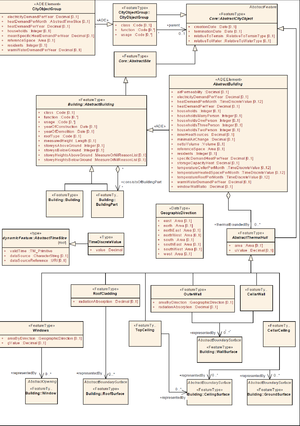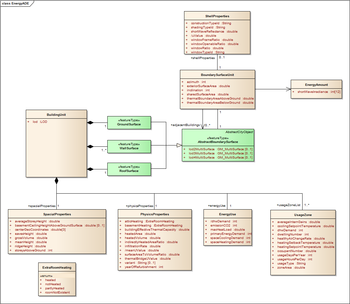Difference between revisions of "2014 S Workshop Topics"
| (4 intermediate revisions by the same user not shown) | |||
| Line 11: | Line 11: | ||
! Presenters (Organisation) !! Presentations | ! Presenters (Organisation) !! Presentations | ||
|- | |- | ||
| − | | Prof. Dr. Coors <br/> (HFT - | + | | Prof. Dr. V. Coors <br/> (HFT - Geoinformatics) || |
| − | + | [[media:Coors_Energy_ADE_Intro.pdf|CityGML and its existing building model]] | |
|- | |- | ||
| − | | R. Nouvel <br/> (HFT - | + | | R. Nouvel <br/> (HFT - Energy) || [[media:Nouvel_Urban_Energy_Simulation.pdf|Review of urban energy simulation models and their data requirements]] |
|- | |- | ||
| − | | Dr. Perez <br/> (former EPFL) || Issues and challenges specific to urban energy models | + | | Dr. D. Perez <br/> (former EPFL) || Issues and challenges specific to urban energy models |
|- | |- | ||
| K.-H. Haefele <br/> (KIT) || [[media:Haefele_IFC-gbXML-V2.pdf|IFC and gbXML, 2 Building information models for building performance simulation]] | | K.-H. Haefele <br/> (KIT) || [[media:Haefele_IFC-gbXML-V2.pdf|IFC and gbXML, 2 Building information models for building performance simulation]] | ||
| Line 27: | Line 27: | ||
| '''First proposals Energy ADE''' | | '''First proposals Energy ADE''' | ||
|- | |- | ||
| − | | ''' | + | | '''R. Kaden''' - [[media:EnergyADE_TU-Muenchen.pdf|Draft Energy ADE of TU Munich]] |
| − | [[File:UMLdiagramm_ADE_Energy_TU_Munchen.png|right|300px|EnergyADE proposal of | + | [[File:UMLdiagramm_ADE_Energy_TU_Munchen.png|right|300px|EnergyADE proposal of TU Munich]] |
| − | * Main features of this | + | * Main features of this EnergyADE |
| − | This | + | This EnergyADE is "EnEV-conform" (EnEV = German thermal regulation). The present scope is only the calculation of space heating and cooling demand <br/> |
| − | + | Modeling decision: The thermal hull is modelled separately from the existing boundary surfaces of CityGML, so as to be fully independant of the CityGML LOD and be able to model complex thermal hull (attic storey and cellar partly heated etc.) | |
| − | The data | + | The data model follows fully the required inputs from the EnEV algorithm (8 facade surface area for the orientations N, NE, E, SE etc...). |
* Remarks of the audience: | * Remarks of the audience: | ||
Why don't you keep the full information concerning the boundary surface orientations? <br/> | Why don't you keep the full information concerning the boundary surface orientations? <br/> | ||
| − | Why should the | + | Why should the EnergyADE be restricted to this German regulation? |
|- | |- | ||
| − | | ''' | + | | '''R. Nouvel''' - [[media:EnergyADE_SimStadt.pdf |Draft EnergyADE of project SimStadt]] |
[[File:Uml-energy-ade.png|right|350px|HFT Stuttgart UML Energy ADE]] | [[File:Uml-energy-ade.png|right|350px|HFT Stuttgart UML Energy ADE]] | ||
| − | * Main features of this | + | * Main features of this EnergyADE |
| − | This | + | This EnergyADE is designed first for steady state simulation (yearly, monthly balance) but may be extended for dynamical simulation (hourly time step). The present scope is only the calculation of space heating / cooling and domestic hot water demand <br/> |
| − | + | Modeling decision: The thermal shell/hull is integrated into the existing boundary surfaces of CityGML, with the introduction of new thermal parameters (thermalBoundarySurfaceAboveGround, thermalBoundarySurfaceUnderGround, sharedSurfaceArea etc.). The new object "BuildingUnit" is introduced as reference simulation object. It can be either a CityGML Building, a CityGML BuildingPart, or possibly CityGML Room in the case of LOD4. The EnergyADE is connected to building libraries (construction, windows, usage etc...). | |
* Remarks of the audience: | * Remarks of the audience: | ||
| Line 52: | Line 52: | ||
| '''Open discussion''' | | '''Open discussion''' | ||
|- | |- | ||
| − | | What is the scope of the | + | | What is the scope of the EnergyADE ? |
* calculation of all building energy demands (with physical and statistical models), energy generation and energy supply. | * calculation of all building energy demands (with physical and statistical models), energy generation and energy supply. | ||
| − | * Modelling of Building Physics, HVAC Systems inside the building (geometrical information not necessary), HVAC controls and set-points, Building usage and occupants (maybe later outsourced into a | + | * Modelling of Building Physics, HVAC Systems inside the building (geometrical information not necessary), HVAC controls and set-points, Building usage and occupants (maybe later outsourced into a BuildingOccupantADE). |
* should allow a plurality of building simulation models adapted to city scale (steady state energy balance, simplified dynamical simulation etc.) | * should allow a plurality of building simulation models adapted to city scale (steady state energy balance, simplified dynamical simulation etc.) | ||
| − | * The | + | * The CityGML EnergyADE should be a Building Information Model (BIM) like IFC, but in comparison to the latter format, it should tackle city scale energy issues, considering not only the buildings but also energy infrastructure, urban forms, streets, vegetations and other urban objects. |
|- | |- | ||
| − | | Modelling of | + | | Modelling of energy infrastructure (District Heating System etc.)? |
| − | * For the modelling of urban energy network, it exists already data | + | * For the modelling of urban energy network, it exists already data model (specific data model of network simulation softwares and the CityGML UtilityNetworksADE, which could be integrated into the CityGML 3.0 standard being redesigned). Then, no urban energy infrastructure modelling is necessary into the EnergyADE (which focus on building energy). For the connection between the EnergyADE and the network model, connection points (network substations and heat exchangers) are necessary to link the buildings to specified networks. |
|- | |- | ||
| − | | Which parameters should we store for the HVAC systems in CityGML, | + | | Which parameters should we store for the HVAC systems in CityGML, e.g. to match the different data requirements of the different HVAC models? |
* List of standard parameters (nominal power, efficiency, seasonal efficiency etc.) + generic parameters specific to the different models. | * List of standard parameters (nominal power, efficiency, seasonal efficiency etc.) + generic parameters specific to the different models. | ||
|- | |- | ||
| Line 76: | Line 76: | ||
Synchronised with development of CityGML 3.0 on Materials. | Synchronised with development of CityGML 3.0 on Materials. | ||
* Group '''HVAC systems and urban energy infrastructure''' : R. Nouvel, E. Duminil, D. Monien, M. Lauster, D. Perez | * Group '''HVAC systems and urban energy infrastructure''' : R. Nouvel, E. Duminil, D. Monien, M. Lauster, D. Perez | ||
| − | * Group '''Building Occupant''' : R. Nouvel, E. Munoz, J-M Bahu | + | * Group '''Building Occupant''' : R. Nouvel, E. Munoz, J.-M. Bahu |
See also projects "extra-Energy" around. May lead to a "Building occupant ADE". | See also projects "extra-Energy" around. May lead to a "Building occupant ADE". | ||
* Group '''Metadata and scenarios''' : D. Perez, R. Nouvel | * Group '''Metadata and scenarios''' : D. Perez, R. Nouvel | ||
|} | |} | ||
Latest revision as of 13:33, 4 June 2014
1st Workshop ADE Energy - Stuttgart, 27th of May 2014
- Host: Hochschule für Technik - Stuttgart
- List of participants
Morning Presentations
| Presenters (Organisation) | Presentations |
|---|---|
| Prof. Dr. V. Coors (HFT - Geoinformatics) |
|
| R. Nouvel (HFT - Energy) |
Review of urban energy simulation models and their data requirements |
| Dr. D. Perez (former EPFL) |
Issues and challenges specific to urban energy models |
| K.-H. Haefele (KIT) |
IFC and gbXML, 2 Building information models for building performance simulation |
Afternoon Discussion
| First proposals Energy ADE |
R. Kaden - Draft Energy ADE of TU Munich
This EnergyADE is "EnEV-conform" (EnEV = German thermal regulation). The present scope is only the calculation of space heating and cooling demand
Why don't you keep the full information concerning the boundary surface orientations? |
R. Nouvel - Draft EnergyADE of project SimStadt
This EnergyADE is designed first for steady state simulation (yearly, monthly balance) but may be extended for dynamical simulation (hourly time step). The present scope is only the calculation of space heating / cooling and domestic hot water demand
Where do you store your simulation results or measured consumption data? Answer: in the EnergyUse class. |
| Open discussion |
What is the scope of the EnergyADE ?
|
Modelling of energy infrastructure (District Heating System etc.)?
|
Which parameters should we store for the HVAC systems in CityGML, e.g. to match the different data requirements of the different HVAC models?
|
Should we import/convert/store everything into CityGML?
|
| Working groups |
Synchronised with development of CityGML 3.0 on Materials.
See also projects "extra-Energy" around. May lead to a "Building occupant ADE".
|

